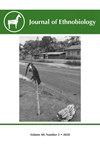Chavín中心地带初始时期晚期(公元前1100-800年)的饮食:来自Canchas Uckro(秘鲁中北部)的新数据
IF 1.3
3区 社会学
Q1 ANTHROPOLOGY
引用次数: 0
摘要
在初始时期晚期(公元前1100-800年),秘鲁高地的孔丘地区见证了礼仪和“原始城市”中心Chavín de Huántar(公元前1000-500/400年)的形成。关于Chavín de Huántar的一个重要问题,集中在它最初建立时的自给经济的性质上。在本文中,我们介绍了动物考古、淀粉颗粒和稳定同位素(δ13C和δ15N)分析的新结果,以重建位于Chavín de Huántar中心地带的Canchas Uckro定居点的饮食。Canchas Uckro建于公元前1100年,在公元前800年之后被遗弃,它提供了对Chavín de Huántar早期阶段社会经济过程的见解。现存的动物遗迹表明鹿是饮食的重要组成部分,而骆驼只占一小部分。从陶器中发现的淀粉颗粒表明,驯化的作物(玉米、土豆和木薯)来自不同的高地生产区。对人类骨骼遗骸样本的δ13C和δ15N分析,结合R (SIAR)混合模型的稳定同位素分析,表明C3植物构成了大部分的饮食,而玉米不是大量消耗。δ13C和δ15N进一步表明鹿占日粮的25-50%。这项研究的结果增加了在广泛采用驯化骆驼之前,秘鲁中北部和北部高地的生存实践数据。本文章由计算机程序翻译,如有差异,请以英文原文为准。
Diet During the Late Initial Period (1100–800 BC) in the Chavín Heartland: New Data from Canchas Uckro (North-Central Peru)
During the late Initial Period (c. 1100-800 BC), the Conchucos region of highland Peru witnessed the formation of the ceremonial and “proto-urban” center of Chavín de Huántar (c. 1000-500/400 BC). An important question regarding Chavín de Huántar centers on the nature of its subsistence economy during the time when it was first founded. In this paper, we present new results from zooarchaeological, starch granule, and stable isotope (δ13C and δ15N) analyses to reconstruct diet from Canchas Uckro, a settlement located in Chavín de Huántar's heartland region. Founded c. 1100 BC and abandoned just after 800 BC, Canchas Uckro provides insight into socioeconomic processes during the early phases of Chavín de Huántar. Extant faunal remains suggest deer comprised an important component of the diet, while camelids constitute a minor proportion of the assemblage. Starch granules recovered from the pottery indicate that domesticated cultigens (maize, potato, and manioc) were obtained from different highland production zones. δ13C and δ15N analysis of a sample of human skeletal remains, coupled with Stable Isotope Analysis in R (SIAR) mixing models, demonstrate that C3 plants constitute most of the diet, while maize was not intensively consumed. δ13C and δ15N further indicate that deer made up 25-50% of the diet. The results of this study add to a gro wing corpus of data on subsistence practices in the north-central and northern highlands of Peru prior to the widespread adoption of domesticated camelids.
求助全文
通过发布文献求助,成功后即可免费获取论文全文。
去求助
来源期刊

Journal of Ethnobiology
Social Sciences-Anthropology
CiteScore
4.80
自引率
3.40%
发文量
21
审稿时长
>12 weeks
期刊介绍:
JoE’s readership is as wide and diverse as ethnobiology itself, with readers spanning from both the natural and social sciences. Not surprisingly, a glance at the papers published in the Journal reveals the depth and breadth of topics, extending from studies in archaeology and the origins of agriculture, to folk classification systems, to food composition, plants, birds, mammals, fungi and everything in between.
Research areas published in JoE include but are not limited to neo- and paleo-ethnobiology, zooarchaeology, ethnobotany, ethnozoology, ethnopharmacology, ethnoecology, linguistic ethnobiology, human paleoecology, and many other related fields of study within anthropology and biology, such as taxonomy, conservation biology, ethnography, political ecology, and cognitive and cultural anthropology.
JoE does not limit itself to a single perspective, approach or discipline, but seeks to represent the full spectrum and wide diversity of the field of ethnobiology, including cognitive, symbolic, linguistic, ecological, and economic aspects of human interactions with our living world. Articles that significantly advance ethnobiological theory and/or methodology are particularly welcome, as well as studies bridging across disciplines and knowledge systems. JoE does not publish uncontextualized data such as species lists; appropriate submissions must elaborate on the ethnobiological context of findings.
 求助内容:
求助内容: 应助结果提醒方式:
应助结果提醒方式:


